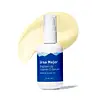What's inside
What's inside
 Key Ingredients
Key Ingredients

 Benefits
Benefits

 Concerns
Concerns

 Ingredients Side-by-side
Ingredients Side-by-side

Water
Skin ConditioningCaprylic/Capric Triglyceride
MaskingCetyl Alcohol
EmollientPropanediol
SolventStearyl Alcohol
EmollientGlycerin
HumectantSodium Hyaluronate
HumectantArginine
MaskingAspartic Acid
MaskingGlycine
BufferingAlanine
MaskingSerine
MaskingValine
MaskingIsoleucine
Skin ConditioningProline
Skin ConditioningThreonine
Histidine
HumectantPhenylalanine
MaskingGlucose
HumectantMaltose
MaskingFructose
HumectantTrehalose
HumectantSodium PCA
HumectantPCA
HumectantSodium Lactate
BufferingUrea
BufferingAllantoin
Skin ConditioningLinoleic Acid
CleansingOleic Acid
EmollientPhytosteryl Canola Glycerides
Skin ConditioningPalmitic Acid
EmollientStearic Acid
CleansingLecithin
EmollientTriolein
Skin ConditioningTocopherol
AntioxidantCarbomer
Emulsion StabilisingIsoceteth-20
EmulsifyingPolysorbate 60
EmulsifyingSodium Chloride
MaskingCitric Acid
BufferingTrisodium Ethylenediamine Disuccinate
Pentylene Glycol
Skin ConditioningTriethanolamine
BufferingSodium Hydroxide
BufferingPhenoxyethanol
PreservativeChlorphenesin
AntimicrobialWater, Caprylic/Capric Triglyceride, Cetyl Alcohol, Propanediol, Stearyl Alcohol, Glycerin, Sodium Hyaluronate, Arginine, Aspartic Acid, Glycine, Alanine, Serine, Valine, Isoleucine, Proline, Threonine, Histidine, Phenylalanine, Glucose, Maltose, Fructose, Trehalose, Sodium PCA, PCA, Sodium Lactate, Urea, Allantoin, Linoleic Acid, Oleic Acid, Phytosteryl Canola Glycerides, Palmitic Acid, Stearic Acid, Lecithin, Triolein, Tocopherol, Carbomer, Isoceteth-20, Polysorbate 60, Sodium Chloride, Citric Acid, Trisodium Ethylenediamine Disuccinate, Pentylene Glycol, Triethanolamine, Sodium Hydroxide, Phenoxyethanol, Chlorphenesin
Aloe Barbadensis Leaf Juice
Skin ConditioningHelianthus Annuus Seed Oil
EmollientGlycerin
HumectantCoco-Glucoside
CleansingCoconut Alcohol
EmollientPopulus Tremuloides Bark Extract
AntiseborrhoeicAscorbic Acid
AntioxidantRosa Canina Seed Extract
EmollientButyrospermum Parkii Butter
Skin ConditioningLeontopodium Alpinum Meristem Cell Culture
Skin ConditioningHydrogenated Lecithin
EmulsifyingGlyceryl Caprylate
EmollientSclerotium Gum
Emulsion StabilisingRosa Damascena Flower Oil
MaskingCitrus Sinensis Peel Oil Expressed
PerfumingRosmarinus Officinalis Leaf Extract
AntimicrobialBisabolol
MaskingSodium Anisate
AntimicrobialLactic Acid
BufferingXanthan Gum
EmulsifyingAloe Barbadensis Leaf Juice, Helianthus Annuus Seed Oil, Glycerin, Coco-Glucoside, Coconut Alcohol, Populus Tremuloides Bark Extract, Ascorbic Acid, Rosa Canina Seed Extract, Butyrospermum Parkii Butter, Leontopodium Alpinum Meristem Cell Culture, Hydrogenated Lecithin, Glyceryl Caprylate, Sclerotium Gum, Rosa Damascena Flower Oil, Citrus Sinensis Peel Oil Expressed, Rosmarinus Officinalis Leaf Extract, Bisabolol, Sodium Anisate, Lactic Acid, Xanthan Gum
 Reviews
Reviews

Ingredients Explained
These ingredients are found in both products.
Ingredients higher up in an ingredient list are typically present in a larger amount.
Glycerin is already naturally found in your skin. It helps moisturize and protect your skin.
A study from 2016 found glycerin to be more effective as a humectant than AHAs and hyaluronic acid.
As a humectant, it helps the skin stay hydrated by pulling moisture to your skin. The low molecular weight of glycerin allows it to pull moisture into the deeper layers of your skin.
Hydrated skin improves your skin barrier; Your skin barrier helps protect against irritants and bacteria.
Glycerin has also been found to have antimicrobial and antiviral properties. Due to these properties, glycerin is often used in wound and burn treatments.
In cosmetics, glycerin is usually derived from plants such as soybean or palm. However, it can also be sourced from animals, such as tallow or animal fat.
This ingredient is organic, colorless, odorless, and non-toxic.
Glycerin is the name for this ingredient in American English. British English uses Glycerol/Glycerine.
Learn more about Glycerin